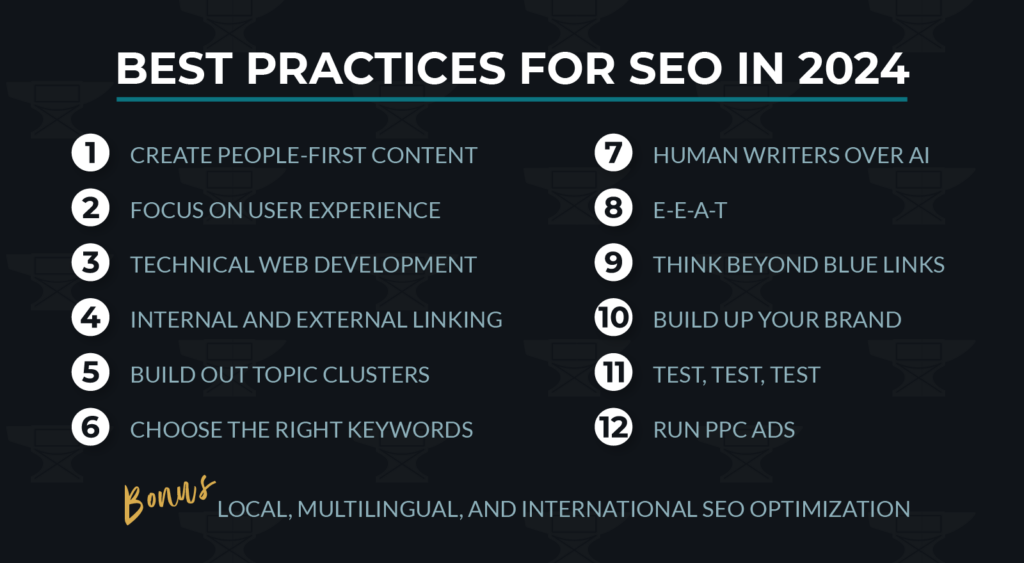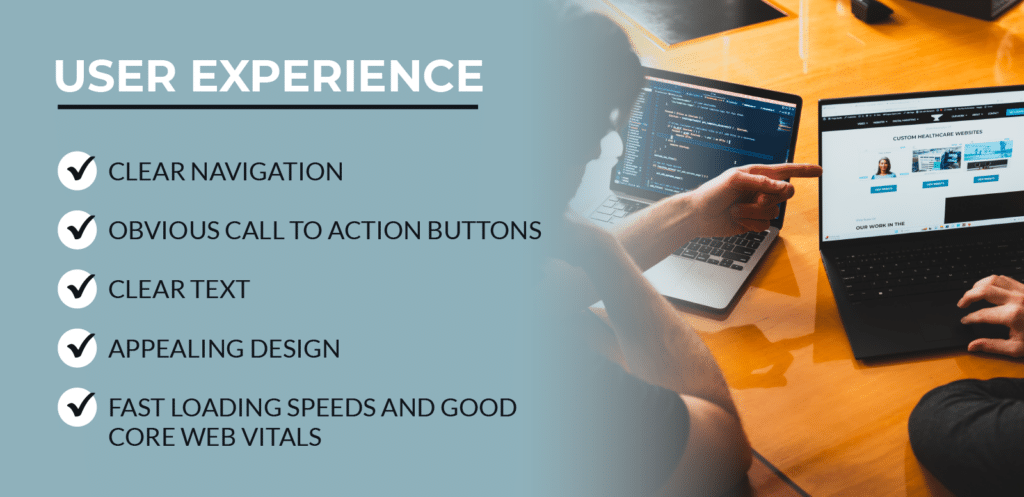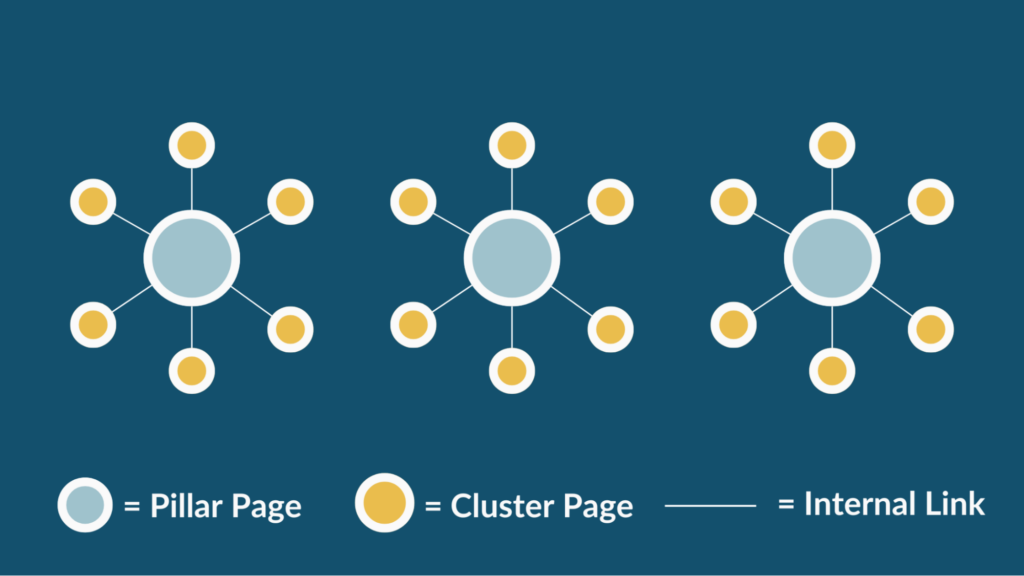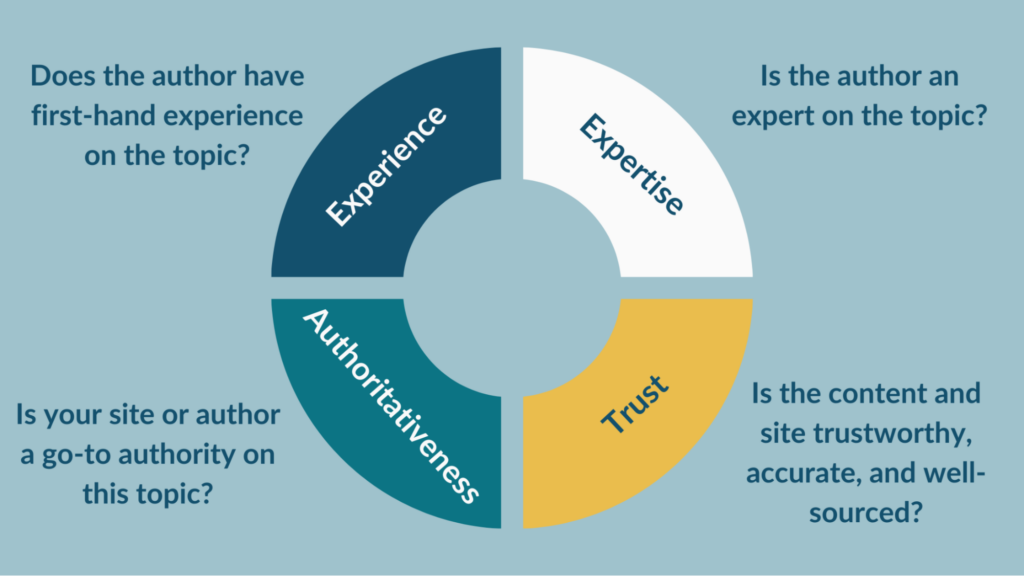Anyone who follows marketing news has seen many shakeups in the last year. Any time a new Google algorithm or major search engine feature comes out, new SEO best practices emerge.
What does it all mean, and how should these 2024 SEO trends affect your strategy?
Forge Apollo is an expert in SEO in Philadelphia. In this article, we’re explaining the current landscape and resulting SEO best practices in 2024. This guide will help you build a foundational strategy with room to dive deeper into technical elements.
2024 SEO Landscape
Before we can dive into best practices, it’s important to understand the current landscape of SEO.
Mistrust
Google has always provided some basic information about how to optimize for their search algorithm. However, it has always been somewhat vague, as they don’t want bad actors to know how to manipulate the system.
As a result, SEOs have always been skeptical of what Google says versus what actually drives results. In fact, one poll found that only 10% of SEOs trust Google. Data revealed in an antitrust lawsuit against Google, followed by a recent API data leak, showed that factors Google told SEOs they did not consider in ranking algorithms, such as user click behavior, are actually part of the algorithm.
AI Uncertainty
Google’s launch of AI overviews in search has sparked concerns among brands about a “zero click future,” where users get their information directly on the results page, bypassing websites entirely. Despite these concerns, many SEOs theorize that AI overviews will likely answer simple, straightforward questions, leaving the nuanced topics that require context to the experts.
This presents an opportunity for brands willing to invest in creating expert-led, complex content to fill the gaps left by AI overviews.

Helpful Content
Google’s “Helpful Content System” launched in 2022 with the goal of identifying more helpful content in search results. With the 2024 March Core Update, Google merged the Helpful Content System into their core ranking systems and reduced unhelpful content in search results by 45%.
Merging helpful content system into their core algorithm is a major signal that Google sees identifying original, valuable content as a core part of its model now.
Best Practices for SEO in 2024

While the current landscape may seem scary, there’s no need to worry. The information from Google’s API leak, the introduction of AI Overviews, and the emphasis on helpful content all lead toward one overarching message:
Google wants to serve high-quality content from reliable sources with first-hand expertise.
These SEO best practices will help you get there.
1. Create People-First Content
Start your strategy by ensuring you have a deep understand your audience and what they want to know.
Ask your team what questions your audience asks or what topics they need more education on. The “People Also Ask” section of search results can be a great place to understand what people want to know about your core topic.
Any content you craft should align first with a need of your audience before your SEO goals. Never fall into the trap of creating content strictly “for SEO,” as every update Google makes works to remove this type of content from results.
2. Focus on User Experience

The Google lawsuit and data leak revealed that the algorithm favors sites with higher user engagement, like clicks and scrolls. So, brands must prioritize a positive user experience on their sites.
Make it easy for users to find what they’re looking for and take the next steps. Include elements like:
- Clear navigation
- Obvious call to action buttons
- Clear text
- Appealing design
- Fast loading speeds and good Core Web Vitals
Mobile Optimization
Ensure your website is optimized for mobile, as Google predominantly uses the mobile version of the content for indexing and ranking.
3. Technical Web Development
Your web developer should follow technical SEO best practices on your website. This includes the technical factors mentioned above and elements like Structured Data (or schema markup) that help search engines better understand your website. This forms the base of your SEO efforts.
4. Internal and External Linking
Internal links (a link from a page on your website leading to another page on your website) help users find more helpful content and help Google understand your site’s structure. When creating these links, use anchor text that conveys where the link leads and matches the user’s intent.
External links (a link from a different website leading to a page on your website) help bring more traffic to your website and improve your authority. There are several link-building strategies out there. Brands should avoid spammy or unnatural link patterns that detract from their authority.
5. Build Out Topic Clusters
Google considers your domain’s topical authority when evaluating your content. Creating clusters of high-quality content around your core topics can build topical authority. Pages unrelated to topic clusters on your site are unlikely to rank well, as they are outside your area of “expertise.”
Start with pillar pages, which include broad information for your core topics. Then, create multiple pages with detailed information linking back to their related pillar page, i.e. your “clusters.”
Here is an example of what a pillar and cluster strategy could look like:

6. Choose the Right Keywords
When choosing topics to flush out your topic clusters, consider the following to choose the right keywords for your brand.
- Competition – What brands are on the first page? If it’s full of massive brands (and you’re not a massive brand), you’re unlikely to make an impact due to the emphasis on brand authority.
- Intent – What are users intents when they search that term? Do they want to find information, navigate to a specific site, or make a purchase? Include a variety of intents in your strategy to reach buyers at each stage of the journey, and match your content to those intents.
- Volume – The higher the volume for a search term, the more traffic you’ll likely get from it. However, don’t ignore low (or zero) volume keywords if they’re highly relevant to your target audience, as SEO tools aren’t 100% accurate in their volume estimations.
- Long-Tail – Consider long-tail keywords over more general ones, as they tend to be easier to rank for and closer to the bottom of the funnel.
When you choose your keywords, be sure to use them (in natural-sounding ways) throughout your titles, headings, and body content.
7. Human Writers Over AI
With AI in search results, Google can produce AI-quality answers to questions independently. Pumping out AI content may get you short-term wins but won’t lead to long-term growth. Utilize your experts and thought leaders to write high-quality, human-authored content.
Of course, you can use AI to aid you in the writing process, like editing and identifying content gaps.
8. E-E-A-T

Displaying E-E-A-T (Experience, Expertise, Authoritativeness, and Trust) is key to establishing reliability. Some strategies brands can use to show E-E-A-T are:
- Create detailed author/employee bios and include them in your content
- Show first-hand experience with the topic
- Include reviews and other social proof
- Create an informative “About” page so users can understand your brand’s expertise
- Make it easy to contact you with a clear contact page and plenty of links to it
- Update your site’s content to keep it fresh and accurate
- Use promotional content sparingly
9. Think Beyond Blue Links
In 2024, the SERP (search engine results page) is so much more than the traditional ten blue links. So, your strategy should think beyond them.
Set up local listings to appear in map packs. Study the structure of content appearing for featured snippets and people-also-ask results for target queries. Create videos and photos with optimized file names and alt text to appear in multi-media results. You can even aim to appear in AI overviews, although the benefit of those is unclear at this time.

10. Build Up Your Brand
Unfortunately, rankings don’t rely on content quality alone. So, it’s vital to build up your brand’s overall reputation.
This starts with establishing E-E-A-T, as we’ve mentioned. Then, the bulk of the work continues off of your site, with efforts such as:
- Getting positive reviews on local listings
- Building engagement for your brand on social media and industry publications as a thought leader
- Running ads on various platforms to increase brand awareness
- Providing service that delights your customers
11. Test, Test, Test
With the questionable reliability of Google’s SEO guidance, it’s important to test for yourself. Even small sites can run small-scale tests on elements such as:
- Keyword Usage
- Call to Action Placement and Text
- URL Structure
- Content Types
12. Run PPC Ads
SEO does not exist in a silo in 2024. All your other marketing efforts support SEO by increasing brand recognition and engagement.
Running PPC ads can effectively supplement your SEO strategy, as they drive brand awareness and engagement on your website for strategic queries.
13. Bonus: Local, Multilingual, and International SEO Optimization
If you’re a business serving specific geographic areas, don’t forget to do the following for local SEO optimization.
- Include geo-specific keywords on your website
- Set up local listings with consistent Name, Address, and Phone number (NAP)
- Encourage customers to leave online reviews on your listings
If that audience is international or multilingual, you should also include elements like hreflang tags, localized content, and separate URLs for different languages.
Staying Up to Date in a Period of Change
These best practices offer solid guidance for the core of your SEO strategy. However, we are in a period of constant updates to search and rapidly evolving algorithms. It’s vital to stay up to date on new developments. Some of our favorite SEO news sources include:
Diversify Your Strategy
While SEO provides a long list of benefits, it shouldn’t be the only part of your strategy. The reality is that SEO can be volatile, and a new Google algorithm or feature could severely impact your traffic.
You can’t control or be 100% prepared for Google’s actions, so focus on what you can control. Build a diverse strategy so no single channel holds up your business.
Turn to Experts if You Feel Overwhelmed
Following 2024 SEO trends and best practices can feel like a full-time job. Luckily, with Philadelphia SEO services from Forge Apollo, it doesn’t have to be your job. Our team of SEO and digital marketing experts follow up-to-date SEO best practices to help your brand reach your organic goals. Contact us today to learn more or get started.






